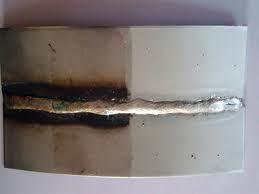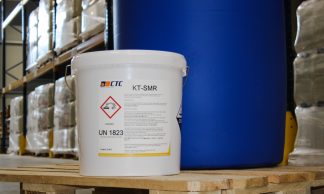If this is newly installed stainless pipe, and it is your desire to improve the chrome content of the ID, thereby improving resistance to corrosion, then you should only use a degreasing solvent sufficient to remove any oils or preservatives that may be present from the manufacturing process. Be patient Repeat it a fair number of times before resorting to the more severe cleaning methods. It allows users to collect data on the size and speed of falling particles. Fumes from citric acid are not toxic and not harmful to the atmosphere. ecolab acid Rinse well with clean water and wipe dry. All grades and finishes of stainless steel may in fact stain, discolor or attain an adhering layer of grime in normal service. This system can handle it all. Nitric acid is a friendly acid towards Stainless Steel and is the only mineral acid which should be used to clean stainless steel. Repeat if necessary. At the Advanced Materials Show 2022,AZoM caught upwith the CEO of Cambridge Smart Plastics, AndrewTerentjev. Washing with soap or a mild detergent and warm water followed by a clean water rinse is usually quite adequate for domestic and architectural equipment.
If this does not suffice, final resort may have to be made to the use of both coarser abrasive cleaners and nylon scouring pads, but with the risk that the surface may become slightly affected. When released in the atmosphere, nitric acid emissions contribute to acid rainand smog, and can affect the ozone layer. Do you have a review, update or anything you would like to add to this article? Table1. Precision Cleaning, Passivation & FinishingSystems. Food handling, pharmaceutical, and aerospace applications may require extremely high levels of cleanliness. Afterwards clean and polish, with a mild abrasive if necessary. At the Advanced Materials Show, AZoM spoke with Vig Sherrill from General Graphene about the future of graphene and how their novel production technique will lower costs to open up a whole new world of applications in the future. This 3-in-1 system offers 3 different automated passivation options: A key advantage of an automated passivation system is that it is designed to run as a closed-loop system, so the operator is not exposed to chemicals like nitric acid. Do not use ordinary steel wool - iron particles can become embedded in stainless steel and cause further surface problems. Use rag, sponge or fibre brush (soft nylon or natural bristle. Semi-Automated [], Specialty & Custom Industrial Process Systems, Precision Cleaning Chemistries, Solvents, & Fluids, 3M Novec Engineered Fluids, Chemicals, & Solvents, Passivation Equipment & Ultrasonic Passivation Systems for Stainless Steel with Nitric / Citric Acid, Semi-Automated Inline Citric Passivation Solution with Data Tracking, Benchtop Ultrasonic Parts Cleaning Multi-Tank Systems, Automated Ultrasonic Parts Cleaning Equipment Wash-Rinse-Dry, Agitated Immersion Ultrasonic Parts Washer, Machine Shop Parts Washer for Swiss and CNC Precision Parts, Benchtop Ultrasonic Passivation Equipment, Ultrasonic Automated Passivation Equipment, Automated Ultrasonic Passivation System for Medical Device Parts, Passivation Wet Bench for Citric / Nitric Acid, Cleanroom Space Saving Automated Passivation System, Heated Polypropylene Acid Passivation and Rinse Tanks, Agitated Immersion Multi-Tank Passivation Systems. (Some alteration to the surface appearance with result from these severe cleaning operations) Acid treatment must be followed by rinsing in ammonia or soda bicarb solution, and Routine Cleaning. Both nitric acid and citric acid are effective in passivating many grades of stainless steel, and both methods are described in detail in the industry standards ASTM A967 and AMS 2700. Industry standards for citric passivation first came to the aerospace industry, where the QQ-P-35 standard became the AMS-QQ-P-35, which was later replaced by the AMS 2700 standard in the early 2000s. Maybe an ionic surfactant rinse followed by some distilled water would be sufficient. What is Alodine / Chem film / Chromate Conversion Coating? Concentrated Nitric Acid must be handled with care. acetone, alcohol, methylated spirits, proprietary "safety solvents"). To achieve maximum corrosion resistance the surface of the stainless steel must be kept clean. Citric acid passivation offers a safer, more environmentally friendly alternative to nitric acid passivation. 10% solutions are less dangerous, but it is advisable chemtec ctc flchendesinfektion carbonate sodium reiniger Follow polish lines.  is 7 a 1% nitric acid solution will be circulated for two hours and flushed with demineralized water. A small caveat: Keep in mind chromium is attacked by strong warm alkaline solutions, so with prolonged contact you may preferentially etch some of the chromium from the stainless. Electropolishing Cycle and Current Calculator. Mild cleaning solutions, eg. If no dulling of the surface can be tolerated a trial treatment should be carried out; especially for pickling operations. Does it affect the passivation layer inside SS pipe. Always attempt the mildest cleaning method first. stainless steel drums barrels drum gallon barrel kegs grade Steel and is the only mineral acid which should be used My question is 1.) Minimize the re-occurrence by applying a wax based household polish to the dry, cleaned surface. Soak well in warm water, rubbing periodically with a soft soapy cloth or sponge.
is 7 a 1% nitric acid solution will be circulated for two hours and flushed with demineralized water. A small caveat: Keep in mind chromium is attacked by strong warm alkaline solutions, so with prolonged contact you may preferentially etch some of the chromium from the stainless. Electropolishing Cycle and Current Calculator. Mild cleaning solutions, eg. If no dulling of the surface can be tolerated a trial treatment should be carried out; especially for pickling operations. Does it affect the passivation layer inside SS pipe. Always attempt the mildest cleaning method first. stainless steel drums barrels drum gallon barrel kegs grade Steel and is the only mineral acid which should be used My question is 1.) Minimize the re-occurrence by applying a wax based household polish to the dry, cleaned surface. Soak well in warm water, rubbing periodically with a soft soapy cloth or sponge.
Chemical handling safety equipment and extreme care required for most use, Minimum chemical handling safety equipment required, Excellent passivation of most grades of stainless steel, Excellent passivation of nearly all grades of stainless steel, Regular solution monitoring required (titration), Regular solution monitoring required (specific gravity), Long-term corrosive degradation of non-stainless steel metal or polymer-based equipment or components, Must control time and temperature closely as danger of nitric oxide gas exists proper ventilation required, Less prone to time and temperature variation, no hazardous vapors, Meets requirements as referenced in ASTM A967, Meets requirements as referenced to AMS 2700 and ASTM A967, More environmentally friendly No nitrogen oxide vapors (NOx) that contribute to smog and acid rain and affect the ozone layer of the atmosphere. Dilute 10% solutions are less dangerous, but it is advisable to wear rubber gloves and eye protection. Except as noted, each of these types of passivation equipment can be built for use with either citric acid or nitric acid. For one medical device manufacturer, the design of a citric passivation solution faced two major challenges: The manufacturing process required performing a water-break test after cleaning parts, before proceeding to passivation. How does it work? Use a thin paste of soda bicarb in hot water, and rub with a fine nylon scouring pad. Do you think it would be wise to use an inhibitor with the Nitric Acid ? Remove burnt food by soaking in hot water with detergent, baking soda or ammonia. We can help. Follow polish lines. CapitalEquipment Use Routine Cleaning. 2. of 7 the lines will be blown dry using dry nitrogen. Q. Hi. Wear rubber gloves, mix the solution in a glass container, and be very careful with the acid. By continuing to browse this site you agree to our use of cookies. Repeat this treatment until no re-occurrence of the rust spot occurs. from most chemists, who will make up the 10% solution. Our automated passivation equipment is particularly well-suited for nitric acid passivation, due to reduced worker interaction with hazardous chemicals. Whether it's citric acid or nitric acid passivation, Best Technology can provide a system that's right for your company. Citric acid is an organic acid that comes from citrus fruits like oranges, and as such is safe for employees to handle. Soap and warm water or organic solvent (eg acetone, alcohol, methylated spirits). This meant that they could not use a fully automated passivation solution. Many people ask about the differences between nitric acid and citric acid for passivating parts made of stainless steel (SS), titanium (Ti), and other alloys. It may be obtained from most chemists, who will make up the 10% solution. After you comply with that spec/code will come the next question of what you are using the pipe for. If you are seeking a product or service related to metal finishing, please check these Directories: Jobshops
Provided the grade, condition, and surface finish were correctly selected for the particular service environment, fabrication and installation procedures were correct and that cleaning schedules are carried out regularly, good performance and long life will be achieved. Dilute extensively before flushing down the drain. Working environments can also create more aggressive conditions, such as the warm, high humidity atmosphere above indoor swimming pools. Exploring making the move from nitric acid to citric acid? Add the sterilizing solution in the strength as laid down in the instructions. Follow by Routine Cleaning. All treatments must be followed by thorough rinsing. This article provides an end-of-life assessment of lithium-ion batteries, focusing on the recycling of an ever-growing amount of spent Li-Ion batteries in order to work toward a sustainable and circular approach to battery use and reuse. Stubborn Stains and Discolouration. Strong acid solutions (e.g. Rather ASTM A312 [affil. For more details on citric passivation, please see our page on Citric Acid Passivation, including the Compatibility Guide for various grades of stainless steel. Severe rust stains are best removed by swabbing the stain, keeping it moist for 15-20 minutes with a 10% solution of Nitric Acid*, repeating if necessary. Please guide we observe during production of Allen Cap Screw oil hold at head part and which is hard to remove. These environments can increase the speed of corrosion and therefore require more frequent maintenance. Thank You for your time. Parts can be processed in as little as 4 minutes when using citric acid, compared to 20 minutes minimum with nitric acid. An Overview of Post Irradiation Examination (PIE) Techniques, Grinding wheels, wire brushes, linishing belts, Contamination by grinding or welding sparks, Grades with at least 16% chromium (except free machining grade such as 303), 20-50% nitric acid, at room temperature to 40, Grades with less than 16% chromium (except free machining grades such as 416), 20-50% nitric acid, at room temperature to 40, Free machining grades such as 303, 416, and 430F, 20-50% nitric acid + 2-6% sodium dichromate, at room temperature to 50, All stainless steels (except free machining grades), 8-11% sulphuric acid, at 65 to 80, Grades with at least 16% chromium (except free machining grades), 15-25% nitric acid + 1-8% hydrofluoric acid, at 20 to 60, Free machining grades and grades with less than 16% chromium such as 303, 410, and 416, 10-15% nitric acid + 0.5-1.5% hydrofluoric acid, at 20 to 60. The frequency and cost of cleaning of stainless steel are lower than for many other materials and this will often out-weigh higher acquisition costs. is a general guideline for cleaning stainless steel. is the general spec for passivation of stainless steel for non-aerospace and non-medical applications. 
